![[Tunisian flag of 18th and 19th century]](../images/t/tn-19c.gif) by Mario Fabretto, 13 July 1997
by Mario Fabretto, 13 July 1997

Last modified: 2006-02-11 by rob raeside
Keywords: tunisia | africa | crescent | sword |
Links: FOTW homepage |
search |
disclaimer and copyright |
write us |
mirrors
See also:
![[Tunisian flag of 18th and 19th century]](../images/t/tn-19c.gif) by Mario Fabretto, 13 July 1997
by Mario Fabretto, 13 July 1997
This flag is quite common on flag books and charts from the middle of 18th century and until the middle of the 19th century. Among them I remember
Norie/Hobbs (1848),
Rosenfeld (1883), Flaggen Almanack (ca. 1844). It doesn't appear on Le Gras (1858) so I think that its use ended in the first half of the 19th century. The only thing we can say is that flags with many stripes and irregular shape were quite common for the ships sailing from north African ports. From many captured flags we also know that similar flags were used on land also, but with different colors and arrangements. The particular use of them is obscure.
Mario Fabretto, 13 July 1997
I recently saw a French encyclopedia, the 'Grand Dictionnaire Universelle du XIXe Siècle' (Paris 1865), which describes some very different flags for the Tunisia, Egypt and Tripoli. There are no illustrations but the text [for Tunisia] reads as follows:
Tunis: "Rouge, avec croissant et étoile dans un cercle blanc." In other words, the current national flag of Tunisia.Vincent Morley, 15 July 1997
Flaggenbuch (1939) shows this flag as a rectangular flag of nine stripes, the middle one being of double width and green while others are of equal width and alternating yellow and red, i.e. top to bottom YRYRVVRYRY. The green stripe contains the sword of Ali, a split edge dagger in white with multicoloured handle (to hoist). The yellow and red stripes contain five symbols each equally spaced and regularly ordered, so that the topmost stripe has same elements as the bottommost one, the second stripe same as penultimate and so on. There are two kind of symbols - a six-pointed star voided with a disk of different colour, and a disk voided with an other smaller disk of other colour off-centered towards fly and down. Each of the two appears in two different colour combination, the star can be red with green disk or white with blue disk, while the disk can be blue with red disk or green with yellow disk. The first (yellow) stripe contains red star, blue disk, red star, blue disk and red star. The second stripe has the green disk, white star, green disk, white star green disk. The third stripe (second yellow stripe) has the same as the first but the central star is white (actually only above the sword, it's red star below). The fourth stripe is then the same as the second one.
The magnificent flag of the Bey shown here, drawn by Jaume Ollé has a few
minor differences (stars voided in blue are coloured white in Flaggenbuch, there
are also white elements in the sword handle and probably few even lesser ones;
if Jaume was working from Flaggenbuch as source, these might be result of white
elements being rendered as "transparent" by some error, or some other source
might have such differences).
This flag was originally reported as dating from the 19th century. There have been some 15 Beys since the beginning of 19th century until the proclamation of the Republic in 1957. In 1881 Tunisia became a French protectorate, but the flag may be older than that as Tunisia was de facto independent from the Ottomans entirely since 1871 and even before that much autonomy was practiced since before 18th century. So, it is hard to assume anything about the adoption dates, while the abandonment should be easier: in 1957 the Republic was proclaimed, so the Bey's standard was used, presumably, well a year after the end of the French protectorate. (Or was it?)
I recalled the beylical standard was mentioned in an article on Tunisian flags
in The Flag Bulletin, no. 195, Sep.-Oct. 2000,
pp. 171-194. Quoting Smith from pp.185-186:
"Another flag (Fig. 15), possibly introduced by Bey Hussein II, served on many
occasions -- including the proclamation of the new Ottoman constitution on 21
March 1840. Referred to as the "state standard of the Regency," (32) this flag
was more than simply a personal banner of the ruler, although it appeared at
ceremonies and visits in which the bey participated (33). It was regularly used
on the Bardo Palace, on the Citadel of Tunis, and on navy ships (34).
"The design of the standard (35) varied somewhat over the years, but the basic
elements were constant. (...) A simplified version of the standard (four stripes
alternately green and red with sword of Ali overall in white) appeared on the
white oval shield in the arms of the Regency, officially adopted in 1861 but in
use earlier (Fig. 16) -- a rare example of a flag serving as the principal
charge in the coat of arms of a country."
Footnotes are:
(32) Henri Hugon, "Les Emblèmes des beys de Tunis" (Paris: Leroux, 1913), p. 64
(33) Si Hassen Hosni Abdel-Wahab, "Note on the History of the Tunisian Flag"
(Tunis, 1957), p. 3. The author claimed the standard was already three centuries
old.
(34) Ibid and the captions of "Verzameling der Vlaggen by alle natien in gebruik"
(Amsterdam, 1835-1850), a manuscript in the library of the Flag Research Center,
illustration No. 37.
(35) The flag --perhaps an elaborated version of the 1765 standard (...)-- as it
appears in [smi75], p. 55, is an illustration from 1835 reproduced from the
Verzameling.
Santiago Dotor, 16 April 2003
The Bey's standard shown in National Geographic
(1917) is somewhat different from the Flaggenbuch (1939)
version, with a long description and explanation.
Željko Heimer, 12 April 2003
Franciae Vexilla (#15/61, September 1999) has a colour plate showing historical flags of Tunisia, entitled "Les ancêtres du drapeau tunisien". (Ancestors of the Tunisian flag). Tunisia was nominally under Ottoman rule from 1574 to 1881 (French military intervention). According to Pierre
Charrié (loc. cit.), ensigns with six horizontal white and red stripes or with green and red stripes were reported as soon as 1756. The dates reported below correspond to the publication year of each source, when available. Captions are by Jean Renault.
 by Ivan
Sache, 28 September 1999
by Ivan
Sache, 28 September 1999
Semi-elliptic, white field with a black crescent facing the hoist. About 5:6.
 by Ivan
Sache, 28 September 1999
by Ivan
Sache, 28 September 1999
Rectangular dark yellow field with incurvated tail and a white crescent pointing upwards. About 3:5. [Charles V le Sage (1338-1380), king of France (1364-1380), gathered a huge collection of manuscripts.] [Gabes is a port of southern Tunisia located on the eponymous gulf.]
 by Ivan
Sache, 28 September 1999
by Ivan
Sache, 28 September 1999
Charles V Atlas (1375), "Tunis". As Charles V Atlas (1375), "Gabes", but with red field and red fringes along the tail.
Znamierowski (2000) (French edition:
Encyclopedie mondiale des drapeaux) shows on p. 104 (section 'the Muslim
crescent') three flags made of a crescent pointing upwards on a monocolour
field. The Gabes flag is a white crescent pointing upwards on a rectangular
orange field. The Tlemcen flag is a blue crescent pointing upwards on an white
field. Tlemcen, now called Tilimsi since the Algerian toponymic reform, was the
capital of the Central Maghreb in the XIVth-XVIth centuries. The Tunis flag is
a white crescent pointing upwards on an red field.
Unfortunately, Znamierowski does not give precise sources for these three
flags. He mentions, however, that the first flags with the crescent appeared on
portolans and navigation maps of XIVth century. The 'Libro de Conoscimiento' (XIVth
century) shows several flags with a crescent (placement not precisely
described) on a white field:
- Kings of Damas and Lucania: yellow crescent
- Cairo: blue crescent
- Mahdia (Tunisia): purple crescent
- Tunis: black crescent. Image shown here.
- Buda: red crescent.
It is not clear from the text if 'Cairo' flag was the flag of Cairo or king of
Cairo. Same for the three other ones. Znamierowski adds that portolans from the
XIV-XVIth centuries often showed for Tunis one or two white crescents on a red
field. Examples of such renditions are shown here.
Ivan Sache, 11 March 2001
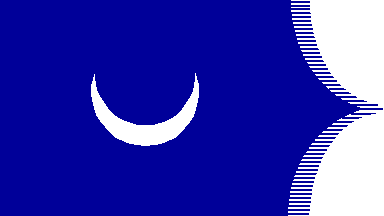 by Ivan
Sache, 28 September 1999
by Ivan
Sache, 28 September 1999
Charles V Atlas (1375). "Tunis, variant". As Charles V Atlas (1375), "Tunis", but with blue field and fringes.
 by Ivan
Sache, 28 September 1999
by Ivan
Sache, 28 September 1999
Venetian portolan (Vesconte). Red field with two white crescent pointing upwards, side by side, and three rectangular tails. About 3:8 (incl. tails). [Portolans are ancient maritime maps showing port location and coast geometry, usually in a fanciful way. They are often ornated with flags, also often fanciful].
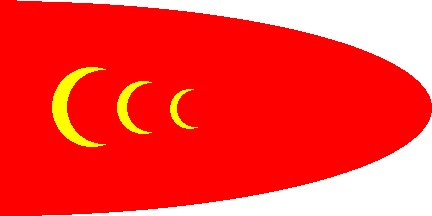 by Ivan
Sache, 28 September 1999
by Ivan
Sache, 28 September 1999
W.Dowmann (1685). Semi-elliptic red field with three yellow crescents facing the fly, side by side with decreasing size. 1:2.
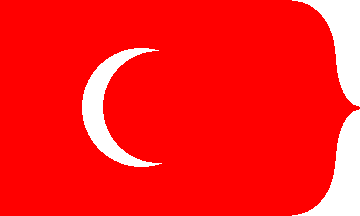 by Ivan
Sache, 28 September 1999
by Ivan
Sache, 28 September 1999
Lems (1700). Red field with a "blazon tail" and a white crescent facing the fly. About 3:5.
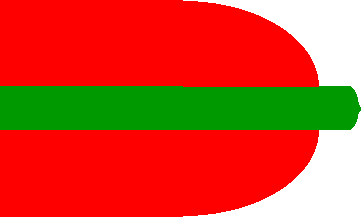 by Ivan
Sache, 28 September 1999
by Ivan
Sache, 28 September 1999
Laurie (1842). "Tongue-like" red field with a green horizontal stripê in the middle, "protruding" at fly. About 3:5.
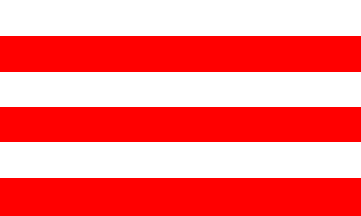 by Ivan
Sache, 28 September 1999
by Ivan
Sache, 28 September 1999
Six horizontal white-red-white-red-white-red stripes. About 3:5.
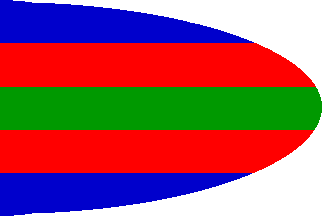 by Ivan
Sache, 28 September 1999
by Ivan
Sache, 28 September 1999
Semi-elliptic, with six horizontal blue-red-green-red-blue stripes. 2:3. Very similar to
Common historical flag of Tunis.
 by Ivan
Sache, 28 September 1999
by Ivan
Sache, 28 September 1999
As Laurie (1842)-variant 2 but rectangular. 2:3.
Ivan Sache, 28 September 1999